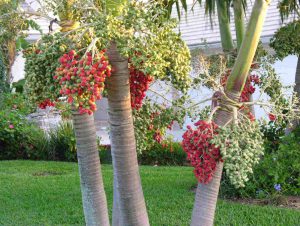
When you imagine the perfect small palm, you might think of one around ten feet tall, with deep-green, feather-like arching fronds about five feet long emerging from a bright green crownshaft on a gray trunk about six inches wide topped at Christmas time with clusters of bright red fruits. Is the Christmas palm the perfect small palm? Like all plants, the Christmas palm has its advantages and disadvantages.
The Christmas palm is a beautiful small palm originally from the Philippines which grows rapidly to six feet tall. This growth spurt then comes to an abrupt pause as it grows very slowly thereafter. To some, the Christmas palm reminds them of a miniature Royal Palm. This is naturally a solitary palm, but you often find it clumped together with other single specimens planted in threes to make a greater display in the landscape. The only problem with this is that often one outgrows the others which may show up as nutrient deficiencies, stunting and/or death. Otherwise, Christmas palms are very well adapted to our soils and normally show few nutrient deficiencies with the exception of some associated with Boron. In general, we would recommend the following for all palms, including Christmas palms, a granular fertilizer – 8-2-12-4 (or 8-0-12-4) applied in November, February and May as per label directions. In August use a 0-0-16-6, again as per label directions.
This Christmas palm is also fairly drought-tolerant and moderately tolerant of salt spray on the foliage. Having a crownshaft, this palm is self-cleaning and does not have to have old fronds pruned – they simply slough off with age. If the hurricane did not topple your Christmas palm, let alone the fruit cluster, the seasonal, bright-red fruit simply adds beauty to an already wonderful palm. The fruit cluster, up to two-feet long, is a natural adornment to this showy palm. If you do not care for the ornamental fruit which can be messy and potentially attract wildlife, it can be cut off any time to avoid the mess of eventual fruit litter.
The Christmas palm is susceptible to the disease called Lethal Yellowing. This however is a rare disease in Charlotte County and is more common well south of us.
One additional consideration – Christmas palms are cold-sensitive and generally can only tolerate temperatures down to thirty degrees F. In fact, we would recommend them for Hardiness Zone 10b which can be a bit limiting to coastal areas and identified microclimates. Growing Christmas palms in large containers for patios can provide mobility if they need to be relocated under cover in the event that a frost/freeze threatens.
The Christmas palm is a neat little palm that fits into many landscape plans including as a Holiday treat for the eyes. Take a look at those in your neighborhood or surrounding landscapes and I am sure that you will find a spot in your yard and heart! For more information on all types of palms, you can also call the Master Gardener Volunteer Helpdesk on Mondays, Wednesdays and Fridays from 1 to 4 pm at 764-4340 for gardening help and insight into their role as an Extension volunteer. Ralph E. Mitchell is the Director/Horticulture Agent for UF/IFAS Extension – Charlotte County. He can be reached at 941-764-4344 or ralph.mitchell@charlottecountyfl.gov. Connect with us on social media. Like us on Facebook @CharlotteCountyExtension and follow us on Instagram @ifascharco.
Resources:
Broschat, T. K. (2017) Adonidia merrillii: Christmas Palm. The University of Florida Extension Service, IFAS.
UF/Gardening Solutions – Christmas Palm. (2022) The University of Florida Extension Service, IFAS.
Landre, C. (2022) Adonidia merrillii: Christmas Palm. South-Florida-Plant-Guide.com.
 1
1
